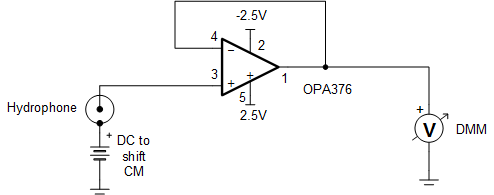I am getting lost in your plethora of OP-Amps. I am looking for product suggestions for a very specific application. This system serves as the primary calibration for hydrophone standards. I need to design a precision unity gain buffer amplifier to interface a hydrophone to a true RMS voltmeter. The input is a direct connection to an un-grounded piezoelectric sphere operating as a balanced charge source across a 4 nF capacitance. The output will drive the single ended 10M ohm input impedance of a Keithley 2000 DMM. The voltage span is 1 mVrms to 300 mVrms, over a frequency span of 1 Hz to 4 kHz. The preferred configuration is to connect the buffer amplifier directly to the BNC connector of the transducer, which is connected directly to the ceramic through 1.5" of wire. The alternate configuration would be to connect the transducer to the buffer with 1m of balanced shielded cable.
-
Ask a related question
What is a related question?A related question is a question created from another question. When the related question is created, it will be automatically linked to the original question.


